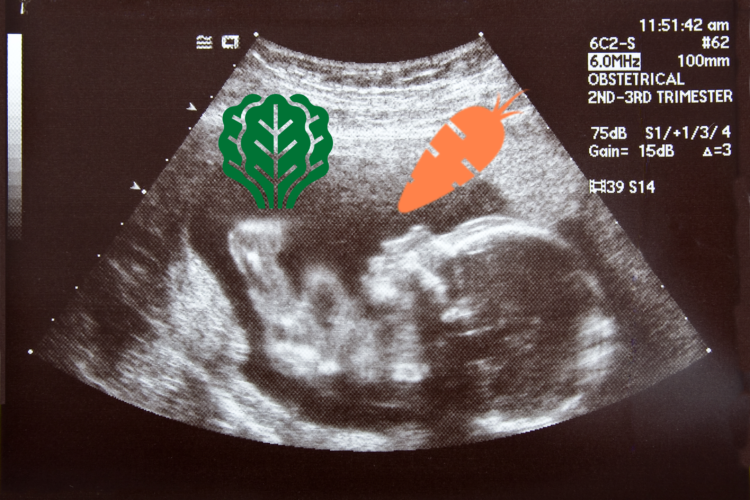It’s a familiar scene for many families interested in fostering children’s preferences for veggies:
It’s dinner time. You are looking forward to sitting down with your family and enjoying the healthy meal you’ve spent the last 30 minutes preparing. The chicken, perfectly browned, emits a delightful fragrance infused with the rich scents of rosemary, thyme, garlic, and onions. The brown rice is fluffy and nutty with a hint of butter and salt. And, the steamed kale is a vibrant green; the perfect mix of soft and crispy. You have high hopes that everyone will enjoy this meal. As you help your 1-year-old settle into her seat and relax into your seat, you prepare to feel proud of your dinner win. You watch as she picks up her kale, carefully inspects it, and places it into her mouth. And…wrinkles her nose, spits it out, and throws it on the floor. Sigh. Your dinner win has turned into a dinner fail. What went wrong?
why would you do this to me?!?

First of all, it’s important to note that nothing went “wrong” with our dinnertime scenario. The reality is that it is very normal for young children to be reluctant to eat vegetables or other healthy foods. Let’s dig into what is going on here. We’ll gain insights from some new research. Then we’ll discuss some early steps we can take when fostering children’s preferences for veggies.
Why Is Fostering Children’s Preferences for Veggies So Difficult?
Research with newborns shows us that we are born with natural preferences for sweet and savory foods. A natural preference for salty foods emerges around 4 months after birth. However, we are also born with a natural aversion to bitter and, to a certain extent, sour foods.
From an evolutionary perspective, this was likely important to our survival when we had to forage in the wild for our food. These preferences ensured we readily accepted breast milk as our first food (which has sweet and savory taste components). These preferences also ensure we were later attracted to the foods in nature that would support our needs for carbohydrates (for example, sweet fruits), protein (for example, meats), and salt for mineral balance. They also ensured that we were more cautious around potentially harmful foods, such as bitter-tasting toxins and sour-tasting rancid foods, and had a quick way to detect and reject potentially harmful substances. Unfortunately, this system means many safe and healthy bitter-tasting vegetables – such as kale, broccoli, and cauliflower – get initially lumped into the “reject” category for young children.
Is There Any Hope for Helping Children Like Bitter Veggies?
Fortunately, research illustrates that children do learn to accept bitter-tasting vegetables if provided repeated opportunities to try them and learn that they are safe – and if they see others eating them within warm and supportive mealtime contexts. And, even better news is that parents can start this repeated exposure to vegetables long before their babies take their first bite of solid foods. Indeed, a fascinating new study by Ustun and colleagues provides direct evidence that during the third trimester, fetuses can detect the flavors of the vegetables their moms eat!
Kale vs. Carrots: Which Do Fetuses Like Better?
Ustun and colleagues studied ~100 pregnant women who underwent routine 4D ultrasounds at 32 and 36 weeks gestation. Twenty minutes prior to their scheduled ultrasound time, 35 women were asked to consume a capsule containing 400mg of carrot powder – equivalent to eating 1 medium carrot. Another 34 women were asked to consume a capsule consuming 400mg of kale power – equivalent to eating 100g of kale. The remaining 30 women were in the control group and did not consume any capsules prior to their ultrasounds. The researchers then analyzed the ultrasounds to track the types of facial movements the fetuses displayed. These facial movements came from previous studies of fetal movements and emotional expressions and were facial movements typically associated with negative emotions (e.g., frowning, brow furrowing) or positive emotions (e.g., smiling). The researchers grouped some of these expressions into “cry face” and “laugher face” movements.
Interestingly, the researchers found that fetuses started to show facial expressions ~30 minutes after their mothers consumed the flavor capsules. Fetuses whose mothers consumed the carrot capsules showed more laughter-face movements compared to the fetuses whose mothers consumed the kale capsules or no capsules. Fetuses whose mothers consumed the kale capsules showed more cry-face movements compared to the fetuses whose mothers consumed the carrot capsules or no capsules. In addition, the researchers noted that fetuses’ cry-face reactions in response to the kale capsules became increasingly complex between 32 and 36 weeks gestation.
Fetuses exposed to carrot flavor showed more “laughter face” movements:

Fetuses exposed to kale flavor showed more “cry face” movements:

So, these findings suggest that fetuses could detect flavors ingested by their mothers and preferred the flavor of a sweeter vegetable (carrot) to that of a more bitter vegetable (kale)!
How to Prepare Your Baby Like Bitter Vegetables
So what do these findings mean? Are we torturing our unborn babies when we eat bitter vegetables like kale during pregnancy? Not at all! An important takeaway from this research is that pregnant persons’ diets flavor the amniotic fluid in ways that fetuses detect, but other research illustrates that this serves an important purpose: it allows the fetus to start learning about the foods of their family and culture well before they ever experience these foods in solid food. In fact, studies show that at weaning, babies show preferences for foods that their mothers ate during pregnancy! So, if you are pregnant, eat a wide variety of healthy foods to start developing your baby’s preferences for these foods. When you start introducing solid foods, you’ll likely notice that your baby shows a preference for your favorite foods!
Want to learn more about fostering children’s preferences for veggies? Read more here!
Enjoying Developing Appetites? Subscribe here to have new posts delivered straight to your email!
